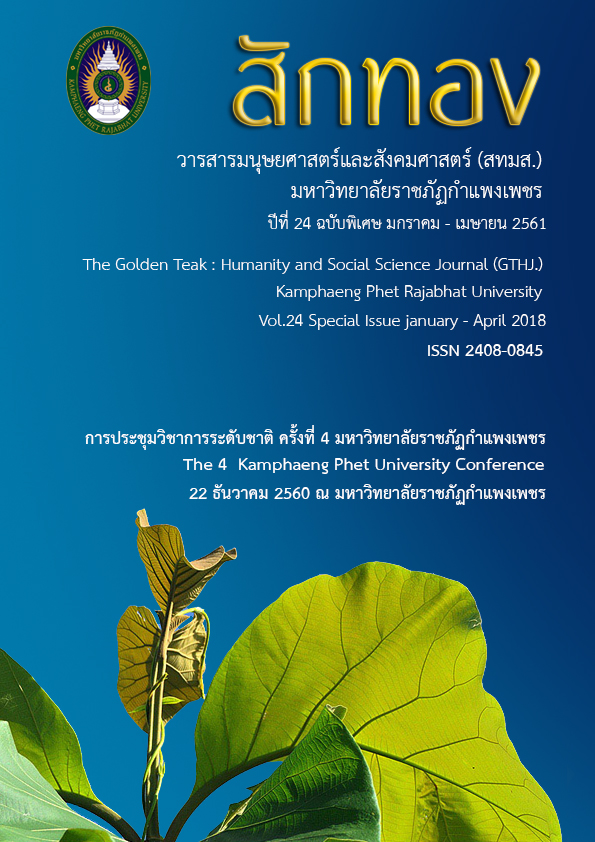Mon Idiomatic Repertoires : a Case Study of Satit Saengboon
Main Article Content
Abstract
The research of “Mon Idiomatic Repertoires : a Case Study of Satit Saengboon” was aimed to study the: 1. Biography of Satit Saengboon 2. Mon idiomatic repertoires and solo repertoires for Khong Mon From the results, it was found that Satit Saengboon started learning Thai music at the age of 8 with Master Sakol Kaewpenkaad. Having undergone the first level of the Chab Mue (Sathukarn) -a traditional initiation to proclaim oneself an apprentice of a specific master, Satit Saengboon continued learning Khong Wong Yai with his master until he was introduced to the second master, Smaan Thongsuchot in the year 1970. Later, Satit Saengboon accomplished superior Nha Paat repertoires as well as Krao Nai solo with Master Saun Wongkhong. Regarding Mon idiomatic repertoires, Satit Saengboon learned a great deal from Master Yen Teh-uan, a Mon descendant of Nonthaburi’s Pak Kret district. Some of the repertoires that Satit Saengboon learned are Yam Thiang, Prac Cham Wad, Pra Cham Baan, Pra Chan Chao, Ching Yai (a monk’s luncheon suite), Num Thong, etc. Apart from learning with Master YEN, Satit Saengboon had a chance to learn extra Mon repertoires while he was working at the Fine Arts Department from Master Chot Duriyapraneet, M.L. Surak Sawaddikul and Master Pradit Nupisin. From the results of the study of ceremonial and general Mon idiomatic repertoires, 3 issues were discussed. 1.) Tone cluster with identical notes, ending tones and melodic scales: it was found that 2 identical cluster was mostly observed, followed by 3, 4, 6 and 8 identical clusters, respectively. Pra Cham Baan was found to have the most identical number of notes, ending tones and melodic scales. 2.) The primary melodic scales of Mon idiomatic repertoires were the C and F scale; B, E, and D being the secondary melodic scales. 3.) Relationship between tone clusters and melodic phrases: it was found that the cluster of 2 and 3 tones were mostly found in the first melodic phrase whereas the cluster of 4, 5 and 7 tones were scattered between the first and second melodic phrase. The cluster of 6 tones was, on the other hand, largely found only in the second melodic phrase. Playing techniques of Khong Mon solo mostly resembled of that executed on Khong Wong Yai although there are certain techniques that were Khong Mon-specific that is Khu Thang (intervals greater than octave). It was found in Phya Sok solo for Khong Mon that the 9th interval was observed 3 times while the 10th octave were observed just once.
Article Details
บทความที่ได้รับการตีพิมพ์เป็นลิขสิทธิ์ของวารสาร สักทอง : วารสารมนุษยศาสตร์และสังคมศาสตร์ สถาบันวิจัยและพัฒนา มหาวิทยาลับราชภัฏกำแพงเพชร
ข้อคิดเห็นใดๆ ที่ปรากฎในวารสารเป็นวรรณกรรมของผู้เขียนโดยเฉพาะ ซึ่งมหาวิทยาลัยราชภัฏกำแพงเพชรและบรรณาธิการไม่จำเป็นต้องเห็นด้วย
References
Samutprakran. Bangkok : Srinakharinwirot University.
Boonpuk, P. (2015). Pi-ie Part Monram. Nonthaburee : Information office Sukhothai
Thammatirat University.
Kaewbucha, M. (1999). An analytical study of the performance and practice of Mon
style Pleng Prajam Ban using Khong Mon Wong Yai. Thesis in Master. Arts (Music), Graduate School, Mahidol University.
O-charoen, S. (2009). The Mons in Thailand : The Evacuation of predicament and
Mons multiculture in siam. Bangkok : Thammasart University.
Phunsue, V. (2015). Pi-ie Part Mon. Bangkok : Srisanae printing.
Trade union of the teachers. (1962). The substantce, Majesty. Volume 18th, The
handwriting of His Royal Highness Prince Chitcharoen, The Prince Narisara Nuwattiwong and His Royal Highness Prince Ditsawarakuman, The Prince Damrong Rajanubhab. Bangkok : Trade union of the teachers printing.


